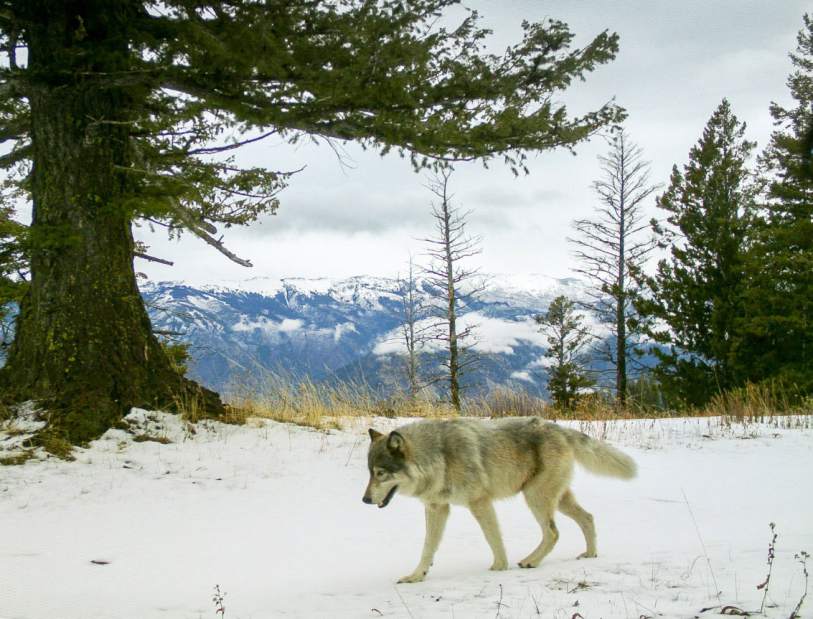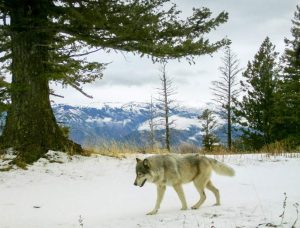Biologists begin wolf counts
Wallowa County wolf pack territories are in transition
ENTERPRISE — As the end of the year approaches, wildlife biologists are gathering data on Oregon’s wolf population even as increased numbers complicate long-term management of the animals.
In Flora, Shamrock Pack sightings have become a regular occurrence. Mike Hansen, assistant wildlife biologist at the Oregon Department of Fish and Wildlife Enterprise office, said this week he investigated a report of wolves in and around a ranch house in northern Wallowa County.
Hansen said confirmed wolf tracks were seen coming through a horse pasture, within 50 feet of the house and within a foot of a chain-link dog kennel.
“The homeowner said this was not the first time,” Hansen said. “They had seen wolves in their yard on at least three occasions.”
Last week, a homeowner reacting to her dog barking inside the house saw wolves approximately 40 feet from the front door.
The wolves have been seen on Lost Prairie outside of Flora multiple times. So far, they have not shown aggression in these residential sightings. However, the Shamrock Pack has been implicated in livestock kills, most recently a calf found badly injured last month on the Zumwalt Prairie. The calf had to be euthanized, according to Rod Childers, a member of the Oregon Cattlemen’s Association wolf committee.
As wolf numbers and packs increase, the territories change. Biologists are trying to sort out wolf packs that are now inhabiting the Imnaha River country where the state’s best-known pack, the Imnaha Pack, was established around 2008.
Last spring, the aging alpha male and crippled alpha female of the Imnaha Pack, along with two of their offspring, were killed by wildlife managers after repeated loss to livestock over the course of a few months in a relatively small area northeast of Enterprise. Hansen said as other packs expand their territory, OR-4 and the three wolves running with him last year may have been pushed into the prairie.
“As alphas get older and weak, they are not as successful at reproducing, the pack diminishes and the pack next door pushes them out of their territory,” Hansen said.
While four members of the Imnaha Pack were eliminated, Hansen said four other wolves thought to be part of the pack remained on the divide between the Imnaha and Snake rivers.
Pack territories often can change, even within a year.
“We’ve seen it with the Imnaha pack and others,” Hansen said.
OR-35, a female wolf originally from Umatilla County, was in the Sled Springs Wildlife Unit last month when her collar information indicated she went to the Wenaha Wilderness in Washington.
“Territories are very fluid, and trying to keep track without radios is pretty difficult,” Hansen said. “Even then, you don’t know the reason they moved.”
In October, responding to repeated wolf reports in the Imnaha Wildlife Unit of 11, 12 and 13 wolves, Pat Matthews, Enterprise’s head biologist, trapped and collared a wolf.
“We thought, ‘Great, now we will learn what’s going on,’ and this one turns out to be a disperser,” Hansen said.
The wolf’s radio collar information indicates not long after he was collared, the wolf crossed the Snake River and is now in Idaho’s Frank Church Wilderness, leaving the wolves in the Imnaha River corridor still uncollared and the identity of 14 wolves filmed loping along the east side of the upper Imnaha Canyon unknown.
When asked what pack those wolves might be — Snake River, South Snake River or an expansion of the remaining Imnaha pack — Hansen said right now, it’s anybody’s guess.
The Snake River Pack’s territory appears to still be mostly on the lower Imnaha River in the Snake River Wildlife Unit, while the South Snake River Pack are not where they were last year on the Baker County line. Two other wolves, a male and female pair, have occupied that country in recent months. Roblyn Brown, acting state wolf biologist, said so far this year pups have not been seen with that pair.
Some of Wallowa County’s other well-known wolves, the Wenaha Pack, are off the radar with no collared members reporting data for the last year and a half. The Sled Springs Pack was essentially decimated last summer when the alpha male and female were found dead in north-central Wallowa County.
As biologists continue to get numbers for the 2016 wolf management annual report, Hansen said remote cameras have been installed to get counts of pups. He said they will also fly to locate animals and later in the winter they may try to capture and collar wolves from a helicopter.
Source: Biologists begin wolf counts; Wallowa County wolf pack territories are in transition

